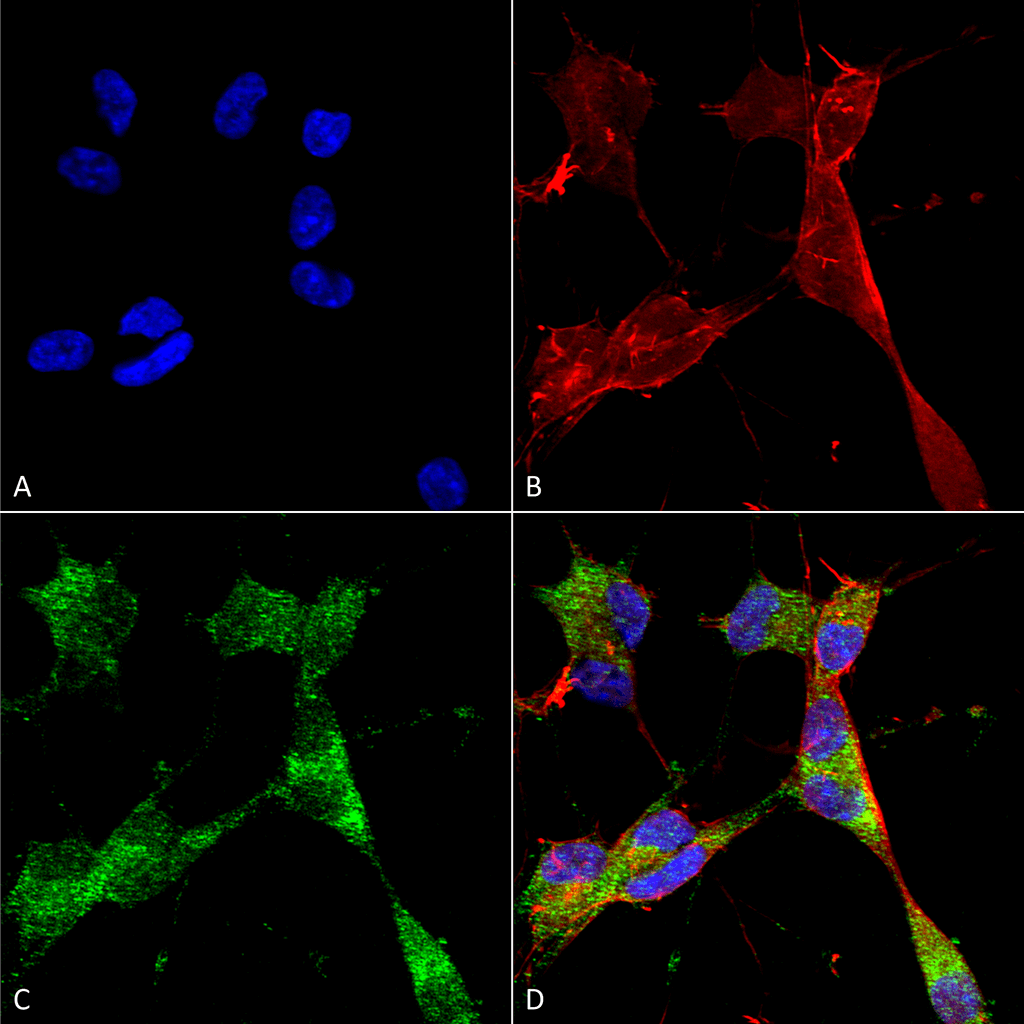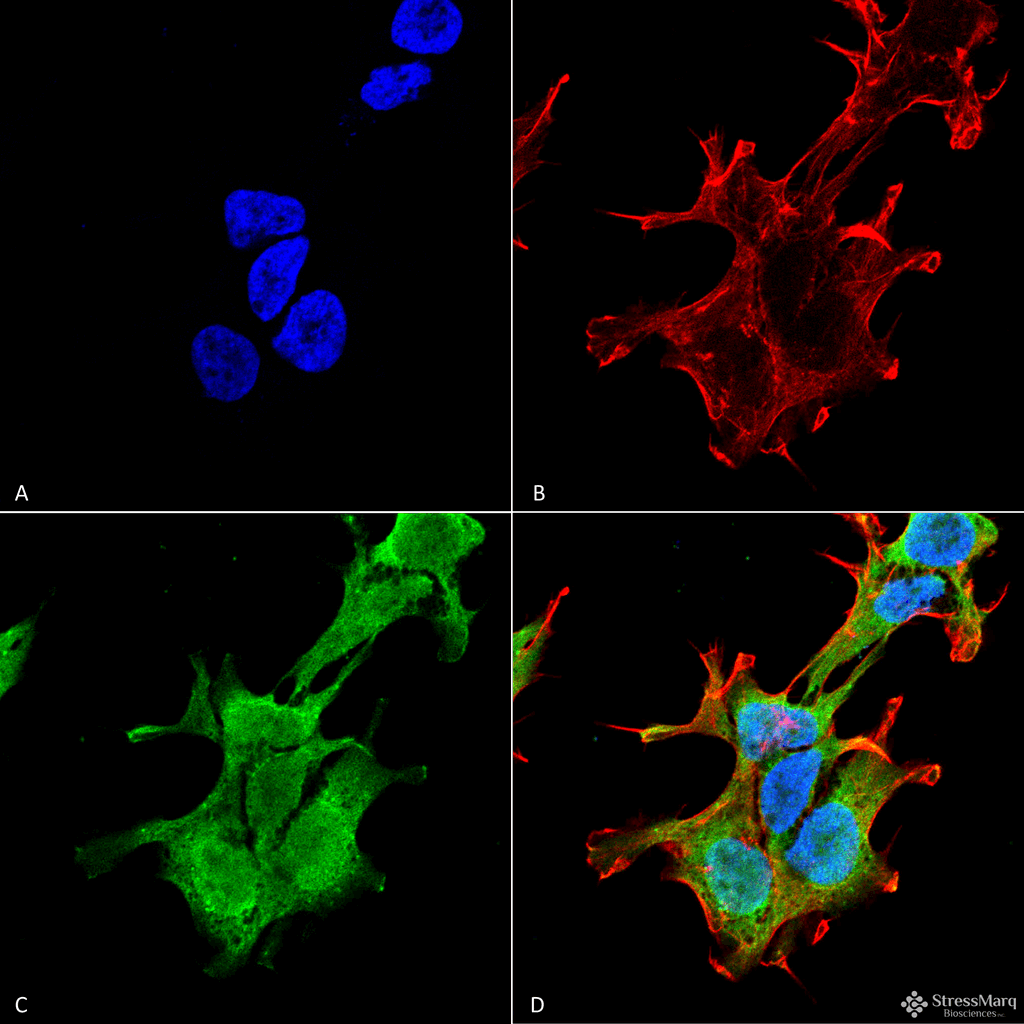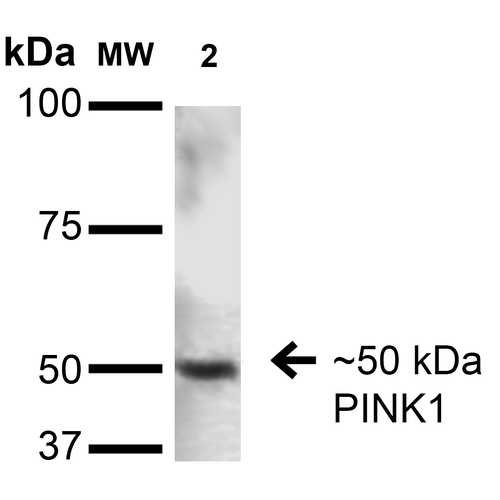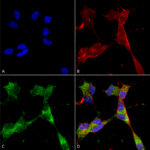Properties
| Storage Buffer | PBS pH 7.4, 50% glycerol, 0.1% sodium azide *Storage buffer may change when conjugated |
| Storage Temperature | -20ºC, Conjugated antibodies should be stored according to the product label |
| Shipping Temperature | Blue Ice or 4ºC |
| Purification | Protein G Purified |
| Clonality | Monoclonal |
| Clone Number | N4/15 (Formerly sold as S4-15) |
| Isotype | IgG1 |
| Specificity | Detects ~50kDa. |
| Cite This Product | StressMarq Biosciences Cat# SMC-450, RRID: AB_2701847 |
| Certificate of Analysis | 1 µg/ml of SMC-450 was sufficient for detection of PINK1 in 20 µg of rat brain lysate by colorimetric immunoblot analysis using Goat anti-mouse IgG:HRP as the secondary antibody. |
Biological Description
| Alternative Names | Parkinson disease (autosomal recessive) 6 Antibody, EC 2.7.11.1 Antibody, PARK6 Antibody, serine/threonine-protein kinase PINK1 mitochondrial Antibody, PTEN-induced putative kinase protein 1 Antibody, protein kinase BRPK Antibody, BRPK Antibody, FLJ27236 Antibody, PTEN induced putative kinase 1 Antibody, Phosphatase and Tensin Homolog Antibody |
| Research Areas | Cardiovascular System, Cell Signaling, Heart, Neurodegeneration, Neuroscience, Parkinson's Disease, Phosphorylation, Post-translational Modifications |
| Cellular Localization | Cytoplasm, Mitochondrion, Mitochondrion outer membrane |
| Accession Number | NP_115785.1 |
| Gene ID | 65018 |
| Swiss Prot | Q9BXM7.1 |
| Scientific Background | PINK1 (PTEN induced putative kinase 1) is a mitochondrial serine/threonine kinase which maintains mitochondrial function/integrity, provides protection against mitochondrial dysfunction during cellular stress, potentially by phosphorylating mitochondrial proteins, and is involved in the clearance of damaged mitochondria via selective autophagy (mitophagy). PINK1 is synthesized as a 63 kD protein which undergoes proteolyt processing to generate at least two cleaved forms (55 kD and 42 kD). PINK1 and its substrates have been found in the cytosol as well as in different sub-mitochondrial compartments, and according to the recent reports; PINK1 may be targeted to OMM (outer mitochondrial membrane) with its kinase domain facing the cytosol, providing a possible explanation for the observed physical interaction with the cytosolic E3 ubiquitin ligase Parkin. Defective PINK1 may cause alterations in processing, stability, localization and activity as well as binding to substrates/interaction-partners which ultimately leads to differential effects on mitochondrial function and morphology. Mutations in PINK1 are linked to autosomal recessive early onset Parkinson's disease, and are associated with loss of protective function, mitochondrial dysfunction, aggregation of alpha-synuclein, as well as proteasome dysfunction. |
Product Images

Immunocytochemistry/Immunofluorescence analysis using Mouse Anti-PINK1 Monoclonal Antibody, Clone N4/15 (SMC-450). Tissue: Neuroblastoma cells (SH-SY5Y). Species: Human. Fixation: 4% PFA for 15 min. Primary Antibody: Mouse Anti-PINK1 Monoclonal Antibody (SMC-450) at 1:50 for overnight at 4°C with slow rocking. Secondary Antibody: AlexaFluor 488 at 1:1000 for 1 hour at RT. Counterstain: Phalloidin-iFluor 647 (red) F-Actin stain; Hoechst (blue) nuclear stain at 1:800, 1.6mM for 20 min at RT. (A) Hoechst (blue) nuclear stain. (B) Phalloidin-iFluor 647 (red) F-Actin stain. (C) PINK1 Antibody (D) Composite.

Immunocytochemistry/Immunofluorescence analysis using Mouse Anti-PINK1 Monoclonal Antibody, Clone N4/15 (SMC-450). Tissue: Neuroblastoma cell line (SK-N-BE). Species: Human. Fixation: 4% Formaldehyde for 15 min at RT. Primary Antibody: Mouse Anti-PINK1 Monoclonal Antibody (SMC-450) at 1:100 for 60 min at RT. Secondary Antibody: Goat Anti-Mouse ATTO 488 at 1:100 for 60 min at RT. Counterstain: Phalloidin Texas Red F-Actin stain; DAPI (blue) nuclear stain at 1:1000; 1:5000 for 60 min RT, 5 min RT. Localization: Cytoplasm. Magnification: 60X. (A) DAPI (blue) nuclear stain. (B) Phalloidin Texas Red F-Actin stain. (C) PINK1 Antibody. (D) Composite.

Western Blot analysis of Rat Brain showing detection of ~50 kDa PINK1 protein using Mouse Anti-PINK1 Monoclonal Antibody, Clone N4/15 (SMC-450). Lane 1: Molecular Weight Ladder. Lane 2: Rat Brain. Load: 15 µg. Block: 2% BSA and 2% Skim Milk in 1X TBST. Primary Antibody: Mouse Anti-PINK1 Monoclonal Antibody (SMC-450) at 1:200 for 16 hours at 4°C. Secondary Antibody: Goat Anti-Mouse IgG: HRP at 1:1000 for 1 hour RT. Color Development: ECL solution for 6 min in RT. Predicted/Observed Size: ~50 kDa.






















StressMarq Biosciences :
Based on validation through cited publications.